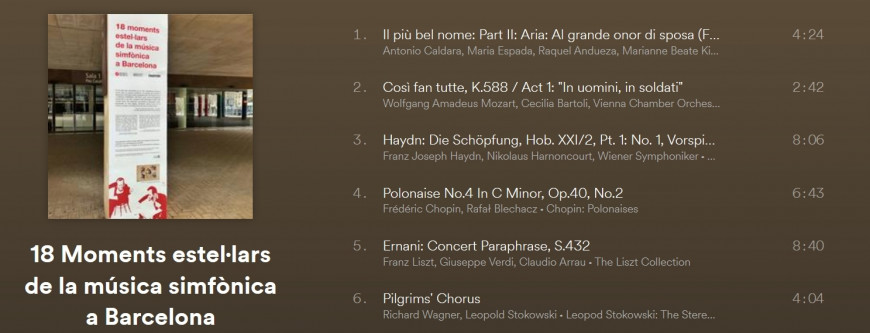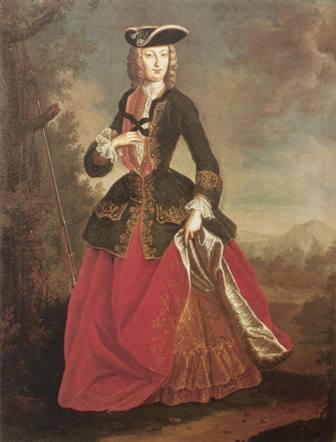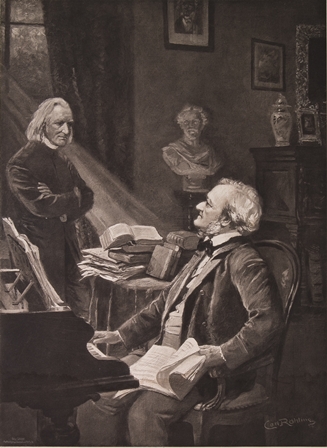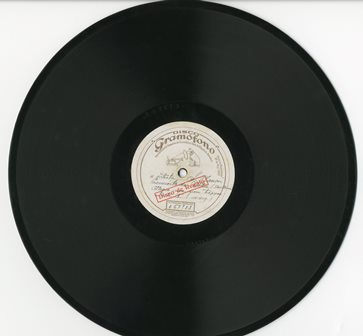
News
18 estelar moments of symphonic music in Barcelona
There are days that focus the artistic experience of a life in one place. Symphonic and concert music in Barcelona has had many of this kind, with great names and unforgettable music. These moments, however, unfortunately tend to be little known to fans. We have chosen only eighteen moments (the columns we had at our disposal) which, spread over three centuries, connect great names of European music to the concert halls of our city.
Museu de la Música de Barcelona
On the occasion of the Barcelona Obertura Spring Festival
Listen here the playlist suggested in the texts.
[1] An opera for Elisabet Cristina
August 2nd 1708
Il più bel nome by Antonio Caldara
Llotja de Barcelona
We do not have reliable data to ensure that the chamber music composition Il più bel nome from the composer Antonio Caldara (1670-1736) was the first opera that was performed in Barcelona. But we do know that on August 2, 1708 at the Llotja de Mar, an opera was performed on the occasion of the royal wedding of Charles III, known as the Archduke of Austria, with Princess Elisabet Cristina of Brunswick-Wolfenbüttel . And we also know that Caldara's opera ended up being performed in Barcelona. Perhaps the title chosen for the wedding day could have been another, the scherzo pastorale L'Imeneo, obviously reminiscent of the mythological god of marriage, Himeneu.
[Oriol Pérez Treviño]

[2] Così fan tutte at Teatre de la Santa Creu
November 4th 1798
Così fan tutte ossia La scuola degli amanti by W. A. Mozart Companyia italiana and Teatre de la Santa Creu’s orchestra, Antonio Tozzi
November 4, 1798 was an important day for the Barcelona opera house: the saint’s day of King Charles IV was celebrated, so those responsible for the Theatre of the Holy Cross released a new opera with double-lighting. The entry fee, consequently, was twice the usual, and Così Fan Futte by W. A. Mozart (1756-1791) with the libretto by L. da Ponte (1749-1838) was performed for the first time in Barcelona. The score had arrived directly from the Imperial Theatre of Vienna, where it had been premiered in January 1790. Barcelona pushed ahead of cities such as Milan and London, demonstrating the outstanding role played by Barcelona theatre in the European musical and operatic context of the decade of the 1790’s. However, Mozart was not successful right away.
[Pepe Reche]
[3] Haydn a la Confraria de Velers
March 21st 1804
La Creació de F. J. Haydn
Principal Hall of Confraria dels Velers
Even today, when we listen to The Representation of Chaos which begins the oratorio The Creation (1798) by Franz Joseph Haydn (1732-1809), we enter into a musical space that leaves us perplexed and confused. It is the same perplexity experienced by the audience at the first listening in Barcelona that took place at the “Confraria dels Velers” (sailboat guild) on March 21, 1804. There was the Baron of Maldà who, in his Calaix de Sastre (multi-volume diary), could not avoid the noise, the violence of this work, to the point that on the day of the premiere, the Baron preferred to listen to it from the street (having attended the dress rehearsal the day before at the house of either Clariana or Múnter) so as not to suffer and "to not break my (his) ears."
[Oriol Pérez Treviño]
[4] Chopin and George Sand
Autumn of 1838
In the autumn of 1838, Frédéric Chopin (1810-1849) passed through Barcelona to embark on El Mallorquín. He went to Mallorca, along with his lover George Sand (1804-1876) and his children, looking for a good climate to heal the tuberculosis he suffered from. They ended up settling in the Carthusian village of Valldemossa, half abandoned: an ideal place for a romantic. He composed, among others, Polonaise in C minor, opus 40 no.2 and Mazurca in E minor, opus 41 no.2. The impact of the couple on the people of the town was a train wreck and, in the end, they decided to return to Paris. Upon returning, according to the diary of Vicenç de Pujol Pastor, they stayed at the palace of the Pastor d'Arenys de Mar (February 1839) where he could play a piano Pleyel recently acquired.
[Oriol Pérez Treviño]
[5] Liszt and Gegant del Pi
April 19th 1845
Franz Liszt closes an European tour in Barcelona
After two weeks in Barcelona, on April 19, Franz Liszt (1811-1886) bid farewell with a concert at the theatre that was in the current Plaza Real. Accustomed to improvisation, to finish the performance he asked viewers to suggest some musical motifs. They sent him a cavatina from the opera Ernani, an Aragonese jota, an unknown song and the popular song El gegant del pi. For a quarter of an hour he expanded, transformed and played with the melodies. With this gesture of kindness and virtuosity, the inventor of the piano recital ended a seven-year tour that had him travel through Europe, from Lisbon to Saint Petersburg. And, unknowingly, he became the first musical celebrity that touched down in the city.
[Joaquim Rabaseda]

[6] Wagner i Clavé
July 16th 1862
Triumphal March from the operaTannhäuser by R. Wagner
Camps Elisis
The first time that the music of Richard Wagner (1813-1883) was heard in the Iberian Peninsula was on July 16, 1862 in Barcelona, at the Carme festival. But it was not at the Gran Teatre del Liceu, which had just been reopened after the fire that destroyed it the previous year, or at the Teatre Principal. It was in the Champs Elysées, the gardens that were on Paseo de Gracia. The piece in question was Triumphal March of the Tannhäuser opera, which 60 men from the Euterpe Coral Society performed along with the female singers of the Liceu choir, as well as more than 60 instrumentalists, directed by Josep Anselm Clavé. He himself had brought this music to Barcelona, which he may have heard at a meeting of choral societies in southern France.
[Aleix Palau]
[7] The Sala Beethoven and Massenet
April 23rd 1881
Jules Massenet with an orchestra of more than one hundred musicians
Sala Beethoven
In the 1870s, Evarist Arnús bought a square block in the Eixample to conserve the theatre and part of the gardens of the Champs Elysées, a hub of leisure in the mid-nineteenth century. He remodeled the space and opened it on April 23, 1881, with a Beethoven Room which had to regularly schedule symphonic music. That is why he hired several instrumentalists for the inaugural function, with an orchestra of more than one hundred musicians. In the first concerts they performed the sixth symphony from Beethoven (1770-1827) and Marche Solennelle, a commission given to Jules Massenet (1842-1912) for the occasion. The French composer opened the doors of the first auditorium of the city with a symphonic and choral movement that in the end intoned a majestic «glory to Beethoven».
[Joaquim Rabaseda]
[8] Richard Strauss i la Banda Municipal
March, 19, 1925
Banda Municipal de Barcelona directed by Richard Strauss
Plaça de Sant Jaume
"Visca Barcelona! Viva Catalunya!" Strauss called (1864-1949) with his arms raised from the balcony of the Palau de la Generalitat. It was on March 19, 1925 and he had just finished directing the Municipal Band in the middle of the Plaza de Sant Jaume after the four visits he made to the city. He invited Antoni Nicolau in 1897 to direct the concerts of the Teatre Líric, and in 1901 for a symphonic program at the Gran Teatre del Liceu. In 1908, Lluís Millet took him to the Palau de la Música, opened three months earlier. And in 1925 he returned to lead the Pau Casals Orchestra. It was then that he heard Municipal Band and he was offered to direct it in a large concert that has left us with memorable images.
[Aleix Palau]
[9] Manén records Beethoven and Mendelssohn
July and November 1916
Concert for a violin and orchestra by L. van Beethoven and by F. Mendelssohn
Orchestra of His Master’s Voice in Barcelona directed by Concordi Gelabert
Joan Manén (1883-1971) was the first violinist in the world to record the violin and orchestra concertos by Beethoven, Mendelssohn (with the strategic elimination of some passages to make them fit in on vinyl records), and also that of Max Bruch in 1921. In those years during World War I, Manén was considered one of the great performers of the world, and took refuge in Barcelona to produce the ambitious recording. The orchestra was small and lacking in strings, as was the case with all recording studios of the time. Thanks to the albums kept at the Music Museum, and other international musical sources, we can once again feel the romantic interpretation of Manén, with a personal melodic line.
[Sara Guasteví]

[10] Orquestra Pau Casals and Stravinsky
Març, 13, 1924
Igor Stravinsky, Orquestra Pau Casals
Gran Teatre del Liceu
On the 13th, 16th and 19th of March, 1924, at the Gran Teatre del Liceu, Stravinsky (1882-1971) directed his compositions for the first time in Barcelona: the suites of The Firebird and Pulcinella, the opera The Nightingale, and other symphonic works. He again repeated the experience the following year, also for Lenten concerts, with the same orchestra and theatre. The composer was valued for some years in the city, especially from 1917 on, when Diàghjilev's company revolutionized ballet at the Liceu. He would still return in 1928, 1933, 1936 and, more discreetly, in 1956. His visits and performances reinforced the success of an avant-garde model that transformed the referents of Catalan culture.
[Joaquim Rabaseda]
[11] Bach’s Passion at Palau de la Música
February 27, 1921
Saint Matthew Passion by Johann Sebastian Bach
Palau de la Música Catalana
Since the re-discovery of J. S. Bach (1685-1750) in the nineteenth century thanks to the efforts of Felix Mendelssohn (1809-1847), the baroque composer's music was consolidated in the programmes throughout Europe. The Orfeó Català was the leader in debuting the brand new choral works on the Iberian Peninsula: Mass in B Minor in 1911 and The Saint Matthew Passion in 1921. In the Passion, the orchestra, directed by Lluís Millet, brought together some outstanding instrumentalists: Eduard Toldrà and Josep Recasens on violin, Gaspar Cassadó on cello and Albert Schweitzer on organ and acting as expert advisor on Bach’s work. Among the soloists were Andrea Fornells, Concepcion Callao and Emili Vendrell singing, of course, the original in German.
[Mercedes Conde Pons]
[12] Arnold Schönberg in Barcelona
November 1931 – Spring of 1932
Baixada de Francesc P. Briz
It is perhaps a little-known event, but Arnold Schönberg (1874-1951) composed a good part of the second act of the opera Moses und Aaron, one of his most significant pieces, in Barcelona. He did it in Vallcarca, at the Baixada de Briz (currently the street that bears his name) where he resided with his wife Gertrud from November 1931 until June 1932. They settled there to look for a good southern climate and Robert Gerhard made sure that his teacher had a good stay. There the couple's daughter, Núria Dorothea, was born, and they always remembered those months fondly. Coincidentally, between April 5 and 7, another great disciple, Anton Webern went to Barcelona to direct the Pau Casals Orchestra.
[Oriol Pérez Treviño]
[13] Berg and the angel at Palau
April 19, 1936
Violinkonzert by Alban Berg premieres at Palau de la Música
Louis Krasner, violinist, and Orquestra Pau Casals directed by Hermann Scherchen
Louis Krasner and the Pau Casals Orchestra premiered Violinkonzert by Alban Berg (1885-1935) at the Palau de la Música Catalana within the XIV Festival of the International Society for Contemporary Music. Dedicated to the daughter of Alma Mahler and the architect Walter Gropius, who had died just a year ago, the work became a posthumous requiem for the same author, who had died a few months ago. The vindication of the memory of an angelic girl and of the now defunct composer became the last lyrical song of a tense and difficult time, the last spring that gave way to one of the longest and most terrible winters in European history.
[Joaquim Rabaseda]

[14] Britten in Montjuïc
Abril 21, 1936
Suite Op. 6 for violin and piano by B. Britten with Antoni Brosa, violin, and Benjamin Britten, piano
Palau de la Música Catalana
Benjamin Britten (1913-1976) stayed in Barcelona in the spring of 1936. He always remembered his happy days in the city, where he met the writer Peter Burra and the composer Lennox Berkeley, all participants in the festival of the International Society of Contemporary Music. Britten released the Op Suite. 6 for violin and piano, accompanied by Antoni Brosa. On April 20, at a festival in Montjuïc, he heard traditional Catalan melodies that were the seed for the Mont Juic Suite. He wrote it in 1937 with Berkeley while receiving horrific news of the war in Catalonia. He dedicated it to his great friend Burra, killed in an airplane accident while training to help the air force of the Spanish Republic.
[Aleix Palau]
[15] Orquestra Municipal, Toldrà and Messiaen
February 22, 1949
Simfonia Turangalila by Oliver Messiaen premieres at Palau de la Música
Orquestra Municipal de Barcelona directed by Eduard Toldrà
Under the title Trois Tâlas, at the Palau de la Música, the Municipal Orchestra of Barcelona premiered three movements of the ten that form the Turangalila Symphony by Olivier Messiaen (1908-1992). This version was presented in Paris, Vienna and Barcelona before the premiere in Boston directed by Bernstein in December 1949. Yvonne Loriod, later to be the wife of the composer, played the piano and Ginette Martenot the Ondes Martenot. Messiaen wrote for Barcelona: "a love song: nostalgic in the first movement, tender in the second, and passionate in the third." When Messiaen came out to say hello, the audience softly protested against his music which was "so modern"; the same happened in Boston.
[Jorge de Persia]
[16] Robert Gerhard at Jardí dels Tarongers
July 11, 1954
Concert per a piano i orquestra de cordes by Robert Gerhard
Jaume Padrós, piano, and Orquestra Catalana da Camera directed by Jacques Bodmer
Jardí dels Tarongers
The program that Josep Bartomeu presented at his home from 1948 until 1958 is, without doubt, an exceptional case in the musical scene of Barcelona. The man who welcomed "music ignored by the old and the experiments of contemporaries" devoted the year of 1953-54 to Arnold Schönberg and his school. At the Schönberg concert, there were works by Jaume Padrós, Joaquim Homs, Manuel Valls and Arnold Schönberg, as well as the Concert for Piano and String Orchestra by Robert Gerhard (premiered in 1951 at the Festival of Aldeburgh). Montsalvatge commented to Destino, "It is impossible to summarize in a few lines the impression of balance, security and clarity that this music produces, which is, in addition, acute, brave and original."
[Martina Ribalta Coma-Cros]
[17] Bayreuth at Liceu
From April 16 to May 1st, 1955
Parsifal, Tristan und Isolde and Die Walküre by R. Wagner in a production of Bayreuth festival
Gran Teatre del Liceu
In April 1955 the Bayreuth Festival left its German sanctuary for the first time. He did it to come to the Gran Teatre del Liceu, with orchestra, choirs and stage design to perform three great Wagnerian myths: Parsifal, Tristan und Isolde and Die Walküre. Eugen Jochum and Joseph Keilberth alternated musical direction, and among a first class vocal cast were Wolfang Windgassen, Hans Hotter, Christl Gotlz and Marta Mödl, framed in the groundbreaking mise en scene from Wieland Wagner. Parsifal had already been performed at the Liceu for the first time outside of Bayreuth on the well-known night of December 31, 1913, taking advantage of the time difference of that time with Germany.
[Aleix Palau]
[18] Alicia de Larrocha opens L’Auditori
March 22, 1999
Concerto breve by Xavier Montsalvatge
L’Auditori
On this day, L'Auditori opened its doors to the public for the first time with a concert by the Barcelona Symphony Orchestra and National Orchestra of Catalonia directed by Lawrence Foster and with Alicia de Larrocha (1923-2009) as soloist. The Barcelona pianist made the walls of the Sala Pau Casals vibrate with a very significant score, the Concerto Breve by Xavier Montsalvatge, which the composer had dedicated to him on the 25th anniversary of his career. Who better to perform this score in such a significant event for the city? A worldwide ambassador of Catalan and Spanish music and, undoubtedly, the most international of all, Alicia chose L'Auditori on another transcendental date: her public goodbye on January 24, 2003, also with the OBC. She was 80 years old and had been on stage for 75 years. It is not surprising that Room 4 of L'Auditori bears her name!
[Mercedes Conde Pons]

